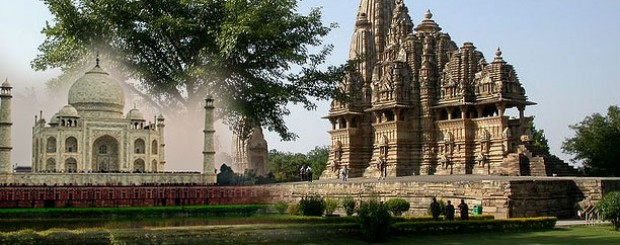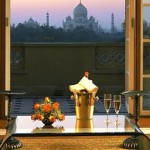Taj Mahal Trip With Khajuraho And Varanasi
DAY 01: ARRIVE DELHI
Arrive Delhi by International flight.
A history which encompasses all the various kings and emperors who fixed their royal citadels here– Indraprastha, Lal Kot, Quila Rai Pithora, Siri, Jahanpanah, Tughlakabad, Ferozabad, Dinpanah, Delhi Sher Shahi or then Shahjahanabad. but, combined and integrated into one, these ‘new cities’ have always been called Delhi and howsoever many names it may have acquired, Delhi has always been intrinsically identified with power and imperial sway.
You will be met on your arrival by the representative of Exotique Expeditions with fresh flower garlands. You will then be transferred to your hotel.
Overnight at the hotel.
DAY 02: IN DELHI
American Breakfast at the hotel.
This morning you will be given the city tour of Ram Niwas Gaeden, JaipurOld and New Delhi.
Old Delhi: – Visit the former centre of Moghul Power, Old Delhi offers ancient monuments, narrow streets and bustling bazaars. Drive past the vast Red Fort, built in 1648, the Jama Masjid, the greatest mosque in India and completed in 1658 by Shah Jahan who also built the Taj Mahal, and the Raj Ghat, the simple memorial to Mahatma Gandhi. A unique experience of taking ‘rickshaw ride’ from the Red Fort, through “Chandni Chowk” or Silver Street, experiencing the sights and sounds of this very busy avenue heading west from the Fort. Chandni Chowk – literally means “moonlit crossroads” and an area which best represents the “super-Oriental” – the glory and the guile; the grandeur and the grime, with its crowded bazaars, twisting lanes, maze of small streets strange aromas, the pungent odour of Oriental spices, the cries of shopkeepers, coolies and “rickshaw-walas” and the clatter and whirr of furious industry.
New Delhi – drive past the stately government buildings of the British Era designed by Lutyens, including the India Gate & the Presidential Palace. Continue onto the beautiful Humayuns tomb of the Mughal era & predecessor of the world famous Taj Mahal, Akshardjam Temple. End the tour at the towering minaret of Qutab Minar
Overnight at the hotel.
DAY 03: DELHI – JAIPUR (265 Kms/165 Miles)
American Breakfast at the hotel.
Leave Delhi for Jaipur by air conditioned vehicle.
The historic city of Jaipur or “The City of Vicotory” was founded in 1727 A.D. by the great Kachhawah ruler Sawai Jai Singh II (1700 – 1747 A.D.), and named after him. The monarch was not only a great builder, but also a poet and an astronomer. Under his aegis, the city was designed by his talented architect Vidyadhar, who gave shape to the creative aspirations of Sawai Jai Singh in the form of the dream city of Jaipur.
Arrive Jaipur and check in at the hotel.
This afternoon you will be given the city tour of Jaipur.
Tour of the Pink City – Your tour will include the imposing City Palace, still home to the Maharaja although several of the rooms are now open to the public. Many antiques and artefacts belonging to the ruling family are housed here, including a collection of weaponry. You will also visit the Hawa Mahal, “Palace of the Winds”, and the open-air Jantar Mantar Observatory to see the vast astronomical instruments. Enjoy a stroll through the colourful bazaar before returning to your hotel.
Overnight at the hotel.
DAY 04: IN JAIPUR
American Breakfast at the hotel.
This morning you will be given excursion to Hawa Mahal, JaipurAmber Fort.
Tour of the impressive Amber Fort, situated on a ridge just outside Jaipur City. At the foot of the hill you will mount your caparisoned elephant for the slow but steady climb up to the main gate, making your entrance in the time honoured fashion. The Fort, completed in the early 18th century, took over 100 years to build and now, although deserted, offers a fascinating insight into the lifestyle of the Moghul ruling families
The afternoon is free. You will have the opportunity to walk around the colorful bazzars, take a by-cycle rickshaw ride or relax on the pool side of the hotel.
Overnight at the hotel.
DAY 05: JAIPUR – AGRA ( 235 Kms/147Miles)
American Breakfast at the hotel.
Leave Jaipur for Agra by air conditioned vehicle.
Agra has a rich historical background, which is amply evident from the numerous historical monuments in and around the city.
Though the heritage of Agra city is linked with the Mughal dynasty, numerous other rulers also contributed to the rich past of this city. Modern Agra was founded by Sikandar Lodhi (Lodhi dynasty; Delhi Sultanate) in the 16th century. Babar (founder of the Mughal dynasty) also stayed for sometime in Agra and introduced the concept of square Persian-styled gardens here.
Agra came to its own when Shahjahan ascended to the throne of Mughal Empire. He marked the zenith of Mughal architecture, when he built the Taj in memory of his beloved wife Mumtaz Mahal.
En-route visit Fatehpur Sikri.
Fatehpur Sikri – Impressive sandstone fortress of Fatehpur Sikri. The fort was built in the 16th century and only occupied for a few years before being abandoned, leaving the buildings in virtually perfect conditions. Continue drive to Agra. Upon arrival in Agra – check-in at the hotel. Thereafter, visit the Red Fort, which was built by Akbar as his citadel over the years 1563-73 in the finest architectural style
Arrive Agra and check at the hotel.
This afternoon you will be given the city tour of Agra.
Visit TAJ MAHAL (Closed on Fridays) – located on the bank of Yamuna River, the most extravagant monument ever built for love. Little needs to be said about this architectural wonder which is always the soul raison-de-etre for every tourist’s visit to Agra. Built by Shah Jahan, the Taj is a white marble memorial to his beautiful wife Mumtaz Mahal. This monument took 22 years to be completed and was designed and planned by Persian architect Ustad Isa. Apart from it’s stunning design balance and perfect symmetry, the Taj is also noted particularly for its elegant domes, intricately carved screens and some of the best inlay work ever seen.
Red Fort – lies on the bend of the river Yamuna, almost in the heart of the town. Akbar built it as his citadel over the years 1563-73 in the finest architectural style. It has imposing gates and walls of red sandstone and a moat.
Overnight at the hotel.
DAY 06: AGRA – JHANSI ( BY TRAIN) – KHAJURAHO
Transfer to the railway station in time to connect train for Jhansi.
In Jhansi, you will be met on arrival and transferred to Khajuraho. En route visit Orchha.
Orchha was founded in the 16th century by the Bundela Rajput chieftain, Rudra Pratap, who chose this stretch of land along the Betwa river as an ideal site for his capital. Of the succeeding rulers, the most notable was Raja Bir Singh Ju Deo who built the exquisite Jehangir Mahal, a tiered palace crowned by graceful chhatris. From here the view of soaring temple spires and cenotaphs is spectacular
Orchha’s grandeur has been captured in stone, frozen in time, a rich legacy to the ages. In this medieval city, the hand of time has rested lightly and the palaces and temples built by its Bundela rulers in the 16th and 17th centuries retain much of their pristine perfection.
Arrive Khajuraho and check in at the hotel.
The name Khajuraho derives from the khajur or date palm trees that once surrounded the huge Khajurvahaka Tal. Khajuraho, once the great Chandela capital, is today a village of about a few thousand people in the interiors of central India, in Chhatarpur district of Madhya Pradesh. Tradition records the existence of eighty five temples, of which only twenty five, strewn amidst lakes and fields, have survived. The temples at Khajuraho, brilliant examples of medieval Indian architecture, were built under later Chandela kings between AD 950 and AD 1050. Each ancient structure in India has a fascinating story to tell. But few match the temples of Khajuraho.
Overnight at the hotel.
DAY 07: KHAJURAHO – VARANASI
This morning you will be given the tour of Khajuraho.
Today transfer to Airport to catch flight to Varanasi.
Picturesquely situated on the crescent shaped left bank of the holy Ganga, Varanasi, one of the ancient seats of learning in India, is said to be a compound of the names of two streams, the Varuna and the Assi, which still flow in the north and south of the city respectively. This name seems to have been corrupted, in medieval times to Banaras, which was in use till May 24, 1956 when it was changed to Varanasi, by an order of the Government of India. Varanasi is probably one of the most ancient living cities in India. From time immemorial it has been a great religious center for Hindus and one of their most sacred places of pilgrimage, being visited by millions of people every year.
On arrival in Varanasi transfer to hotel.
Overnight at hotel.
DAY 08: IN VARANASI
Early morning, leave for boat ride on the Ganges to see the bathing Ghats (river bank) & cremation site. Sunrise on the riverfront, as seen from a boat, can be a spiritually uplifting sight. The life on the Ghats bound in an endless string of rituals, ever-changing aspects of the river & the wide landscape across have fascinated visitors from all over the world. Return to the hotel for breakfast.
City tour of Varanasi – Visit the Bharat Mata temple with a big relief map of India in Marble, Durga temple, Tulsi Manas Mandir, Benaras Hindu University which has an art gallery & the mosque of Moghul Emperor Aurangzeb.
Excursion to Sarnath – the buried Buddhist city where Buddha preached his first sermon. After attaining enlightenment at Bodh Gaya the Buddha went to Sarnath; and it was here that he preached his first discourse in the deer park to set in motion the ‘Wheel of the Dharma’. It is one of the most holy sites as in this place the stream of the Buddha’s teaching first flowed. Sarnath was a renowned school of learning from 16th century BC to 12th century AD. Visit the ruins, the stupa, the Buddhist temple & the museum (closed on Fridays). At the museum is the Ashok Pillar with its four guardian lions, used as independent Indias’ national emblem
DAY 09: VARANASI – DELHI
Transfer to Airport to board your flight to Delhi.
Rest of the day free to do your last minute shopping.
Overnight at the hotel.
DAY 10: DEPARTURE DELHI
Breakfast at the hotel.
Transfer to the airport in time to connect your onward flight.
Social Share
Luxury Tours
Luxury Heritage Tour with Taj Mahal
India Tour Packages
Holiday Inspirations
Useful Links
Contact Us
Suite No 207 RG Complex, Plot-08, Central Market Sector-05, Dwarka
New Delhi 110075
INDIA
Phone : +(91-11) 42730400
WhatsApp: +91-8800222776
CIN : U63040DL2003PTC120106 GSTIN: 07AABCE2211M1ZX

 Fixed Departure
Fixed Departure

